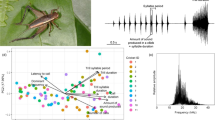Summary
The calling song of the ♂-cricket, Teleogryllus commodus, attracts ♀♀ for mating. Both calling and ♀-locomotor activity are under circadian control and the behaviors occur approximately at the same time. Daily playback of calling songs for 3–12 h in constant light failed to entrain ♀-running. Instead, calling acts as an external stimulus which can release ♀-locomotion at any time of the 24-h period, while the clock-induced activity continues to run freely. The stimulatory effect of the calling song causes flexible extension of ♀-locomotor activity, but a subsequent restorative period is necessary. The ecological consequences of acoustical stimulation are discussed.
Similar content being viewed by others
References
Alexander, R.D., Meral, G.H.: Seasonal and daily chirping cycles in the northern spring and fall field chrickets, Gryllus veletis and G. pennsylvanicus. Ohio J. Sci. 67, 200–209 (1967)
Aschoff, J.: Zeitgeber der tierischen Tagesperiodik. Naturwissenschaften 41, 50–59 (1954)
Aschoff, J.: Exogenous and endogenous components in circadian rhythms. Cold Spring Harbor Symp. Quant. Biol. 25, 11–27 (1960)
Enright, J.T.: Synchronization and ranges of entrainment. In: Circadian clocks. Aschoff, J. (ed.), pp. 112–124. Amsterdam: North-Holland 1965
Gwinner, E.: Entrainment of a circadian rhythm in birds by species-specific song cycles (Aves, Fringillidae: Carduelis spinus, Serinus serinus). Experientia 22, 765 (1966)
Hill, K. G.: Carrier frequency as a factor in phonotactic behaviour of female crickets (Teleogryllus commodus). J. Comp. Physiol. 93, 7–18 (1974)
Hill, K.G., Loftus-Hills, J.J., Gartside, D.F.: Pre-mating isolation between the Australian field crickets Teleogryllus commodus and T. oceanicus (Orthoptera: Gryllidae). Aust. J. Zool. 20, 153–163 (1972)
Hoffmann, K.: Die relative Wirksamkeit von Zeitgebern. Oecologia 3, 184–208 (1969)
Loher, W.: Circadian control of stridulation in the cricket Teleogryllus commodus Walker. J. Comp. Physiol. 79, 173–190 (1972)
Loher, W.: Circadian rhythmicity of locomotor behavior and oviposition in female Teleogryllus commodus. Behav. Ecol. Sociobiol 5, 253–262 (1979)
Lohmann, M., Enright, J.T.: The influence of mechanical noise on the activity rhythms of finches. Comp. Biochem. Physiol. 22, 289–296 (1967)
Menaker, M., Eskin, A.: Entrainment of circadian rhythms by sound in Passer domesticus. Science 154, 1579–1581 (1966)
Meyer, A.: Einfluß von Schall auf die tagesperiodische Aktivität des Goldhamsters. Naturwissenschaften 55, 234–235 (1968)
Nielsen, E.T.: Stridulatory activity of Eugaster (Orthoptera, Ensifera). Entomol. Exp. Appl. 14, 234–244 (1971)
Nielsen, E.T.: Precrepuscular stridulation in Tettigonia viridissima (Orthoptera ensifera). Entomol. Scand. 3, 156–158 (1972)
Nielsen, E.T., Dreisig, H.: The behavior of stridulation in Orthoptera ensifera. Behaviour 37, 205–252 (1970)
Rence, B., Loher, W.: Arrhythmically singing crickets: Thermoperiodic reentrainment after bilobectomy. Science 190, 385–387 (1975)
Rence, B.G.: Exogenous influence on the circadian rhythm of stridulation in the cricket, Teleogryllus commodus (Walker). Ph. D. thesis, Univ. California, Berkeley (1976)
Sokolove, P.G.: Locomotory and stridulatory circadian rhythms in the cricket, Teleogryllus commodus. J. Insect Physiol. 21, 537–588 (1975)
Author information
Authors and Affiliations
Rights and permissions
About this article
Cite this article
Loher, W. The effect of male calling on female locomotor activity of Teleogryllus commodus . Behav Ecol Sociobiol 5, 383–390 (1979). https://doi.org/10.1007/BF00292526
Received:
Issue Date:
DOI: https://doi.org/10.1007/BF00292526




